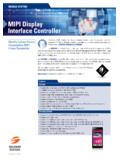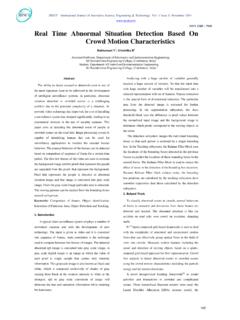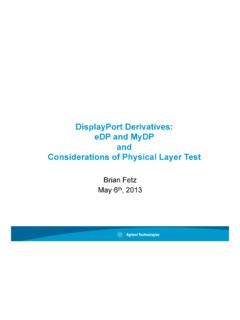Transcription of AVS - The Chinese Next-Generation Video Coding Standard
1 AVS - The Chinese Next-Generation Video Coding Standard Wen Gao1, Cliff Reader2, Feng Wu3, Yun He4, Lu Yu5, Hanqing Lu6, Shiqiang Yang7, Tiejun Huang1, Xingde Pan8 Joint Development Lab., Institute of Computing Technology, Chinese Academy of Sciences, Beijing, Consultant, Chinese Academy of Microsoft Research Asia, Beijing, 100080, Dept. of Electronic Eng. , Tsinghua University. 4 Institute of Information and Communication Engineering, Zhejiang NLPR, Institute of Automation, Chinese Academy of Sciences. 6 Department of Computer Science and Technology, Tsinghua Beijing Media Works Co.
2 Ltd, Beijing, INTRODUCTIONThe Audio Video Coding Standard of China (AVS) Video Standard is a streamlined, highly efficientvideo coder employing the latest Video Coding toolsan d dedicated to Coding HDTV content. All videocoding algorithms comprise an optimizationbetween absolute Coding performance and complexity of implementation. Compared with other standards, AVS has been designed to provide nea r optimum performance and a considerable reduction in complexity. AVS will therefore provide low-cos t has also been designed in such a way that its technology can be licensed without delay and for a ver y reasonable fee. This has required some compromises in the design but the benefits of a non-proprietary, open Standard , and the licensing cost savings easily outweigh the small loss in AVS specification was finalized in December 2003 and will be extensively tested with laboratory verification tests and field tests in 2004.
3 It is expected to be issued as a Chinese National Standard in Summer applications include broadcast TV, HD-DVD, and broadband Video FORMATSP rogressive scanAVS codes Video data in progressive scan format. Thi s format is directly compatible with all content tha t originates in film, and can accept inputs directly fro m progressive telecine machines. It is also directly compatible with the emerging Standard for digital production th e so-called 24p Standard . In the next few years, most movie production and much TV production will be converted to this new Standard . It will als o be the Standard for digital cinema, so there is convergence in the professional film and TV production industry toward a single production format offering the highest original quality.
4 AVS also codes progressive content at higher frame rates. Such rat es may be necessary for televised significant benefit of progressive format is the efficiency with which motion estimation operates. Progressive content can be encoded at significantly lower bitrates than interlaced content with the same per ceptual quality. Furthermore, motion compensated Coding of progressive format data is significantly less complex than Coding of interlaced data. This is a significant component of the reduced complexity of AVS scanAVS also provides Coding tools for interlaced scan format. These tools offer Coding of legacy interlaced format Video . Picture formatAVS is primarily focused on broadcast TV applications with an emphasis on HDTV and therefore will be used principally with a format of 1920 x 1080 pixels.
5 Nevertheless AVS is a generic Standard and can code pictures with a rectangular format up to 16K x 16K pixels in size. Pixels are coded in Luminance-Chrominance format (YCrCb) and each component can have precision of 8 bits. AVS supports a range of commonly used frame rates and pixel aspect ratios AVS supports 4:2:0, and 4:2:2, Chroma formats. Chromaticity is as defined by international STRUCTUREAVS is built on a layered data structure representing traditional Video data. This structure is mirrored in the coded Video bitstream. Figure 1 illustrates this layered structure. Entry point in Bitstream Representation of Video Frame Raster-ordered strip of Macroblocks 6 Blocks; 4 Luminance, 2 Chrominance 8x8 Pixels;Luminance, ChrominanceFigure 1.
6 AVS Layered Data StructureAt the highest layer, sets of frames of continuous Video are organized into a Sequence. The Sequence provides an opportunity to download parameter sets to decoders. Video frames comprise the next layer, and are called Pictures to avoid any ambiguity between legacy Video fields and frames. Pictures can optionally be subdivided into rectangular regions called Slices. Slices are further subdivided into square regions of pixels called Macroblocks. These are the fundamental Coding units used by AVS and comprise a set of luminance and chrominance blocks of pixels covering the same square region of the Picture. The Sequence, Picture and Slice layers begin with unique Start Codes that allow a decoder s parser to find them within the bitstream.
7 An example of a Sequence of Pictures is shown in Figure 2. Figure 2. Video Sequence Example. Sequence The sequence layer comprises a set of mandatory and optional downloaded system parameters. The mandatory parameters are necessary to initialize decoder systems. The optional parameters can be used for other system settings at the discretion of the network provider. In addition, user data can optionally be contained in the Sequence header. The Sequence layer provides an entry point into the coded Video . Sequence headers should be placed in the bitstream to support user access appropriately for the given distribution medium. For example, they should be placed at the start of each chapter on a DVD to facilitate random access.
8 Alternatively they should be placed every -second in broadcast TV to facilitate changing channels. Repeat Sequence headers may be inserted to support random access. Sequences are terminated with a Sequence End Code. Picture The Picture layer provides the coded representation of a Video frame. It comprises a header with mandatory and optional parameters and optionally with user data. Three types of Picture are defined by AVS: Intra Pictures (I-pictures) Predicted Pictures (P-pictures) Interpolated Pictures (B-Pictures) Slice The Slice structure provides the lowest-layer mechanism for resynchronizing the bitstream in case of transmission error. Slices comprise an arbitrary number of raster-ordered rows of Macroblocks as illustrated in the example of Figure 3.
9 Slices must be contiguous, must begin and terminate at the left and right edges of the Picture and must not overlap. It is possible for a single slice to cover the entire Picture. The Slice structure is optional. Slices are independently coded no slice can refer to another slice during the decoding process. Figure 3. Slice Layer example. Macroblock A Macroblock includes the luminance and chrominance component pixels that collectively represent a 16x16 region of the Picture. In 4:2:0 mode, the Chrominance pixels are subsampled by a factor of two in each dimension; therefore each chrominance component contains only one 8x8 block. In 4:2:2 mode, the Chrominance pixels are subsampled by a factor of two in the horizontal dimension; therefore each chrominance component contains two 8x8 blocks.
10 This is illustrated in Figure 4. Figure 4. Macroblock formats. Sequence Header Pictures End Sequence Header Pictures Repeat Sequence Header The Macroblock layer is the primary unit of adaptivity in AVS and the primary unit of motion compensation. The Macroblock header contains information about the Coding mode and the motion vectors. It may optionally contain the quantization parameter. Block The Block is the smallest coded unit and contains the transform coefficient data for the prediction errors. In the case of Intra-coded blocks, Intra prediction is performed from neighboring Blocks. OVERVIEW The AVS Video Coding Standard is based on the classic hybrid DPCM-DCT coder, which was first introduced by Jain and Jain in 1979[1].






